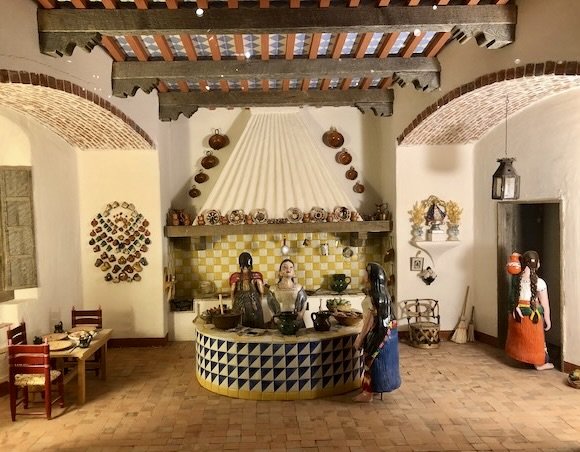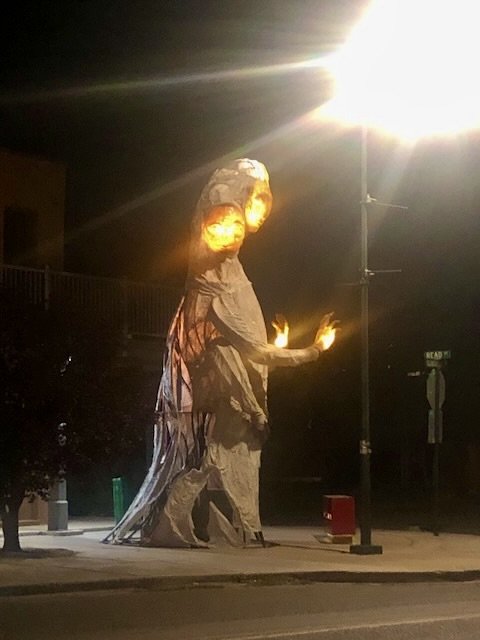Leather Pants
In the early years of my relationship with New York City, I was going to graduate school for film. I had a couple of sources of employment: I worked ten hours a week in the video library. In those days -- when I wasn’t too busy knitting a sweater that a boyfriend would later lose to be bothered to help my fellow students -- we loaned out vhs tapes. I also taught yoga -- mostly at a studio in Triburbia, also known as Tribeca.
It was 1999: it was before the days when you could throw a piece of rose quartz and hit five yoga instructors on any Manhattan sidewalk. Actually, I was head-hunted as a yoga teacher – I kid you not. It wasn’t because I was an extraordinary teacher; I wasn’t. I was good enough. I was good at remembering people’s names, I was disciplined, I was naturally flexible and had been practicing yoga since I was a kid, and I could do a unitard justice. . . but nothing resembling enlightenment had been achieved by 20-something Hilary Downes – neither has it been by 40-something Hilary Downes. Nonetheless, my over-tweezed eyebrows and I sweated and stretched and breathed with other aspiring, perspiring and inspiring city folk at the end of the millennium.
I had already earned the nickname ‘fancypants’ during one of the internships I had in the city during college – a name inspired by my shiny red low-slung flares from Dollhouse, a store which used to exist on Bond Street and Lafayette, just a few doors east of Other Music. I had a taste for idiosyncratic pantalones since the beginning of my clothes-wearing days. In grade school, I remember convincing my mom to indulge me in an Esprit number for back-to-school – they were orange and royal blue-checked, with an exquisite black fish motif. My purple crushed velvet legging phase ruled the early ‘90s in the Pacific Northwest. I had good luck with pants during the year I lived in Florence, Italy – daily slabs of salty, oily focaccia bread notwithstanding. Pants I bought in Italy were, surprisingly, long enough – which was not an easy box to check for me, a tall woman of Norwegian descent. This is all to say that I never had – and still don’t -- big boobs or full lips, or any butt to speak of – but I had long legs, and I celebrated pants. I still do.
One of my first friends in film school was a southerner named Kendall – who ended up becoming ‘my producer.’ I include quotation marks only because I feel and felt undeserving. . . who was I to have a producer -- Kathryn Bigelow? Jane Campion? Maya Deren? Kendall was gifted with a force of will, single-mindedness, and an ability to make things happen. She also happened to have confidence in me. My own sense of confidence was a house of cards: I oscillated between grandiosity and worthlessness. I was drawn to writers like Dorothy Parker and Sylvia Plath; I, too, had angst that I wanted to share with the world. A professional editor who volunteered to edit my thesis - and later fired me - called me ‘Plathological,’ which I thought was clever and insightful, if biting.
When Kendall introduced me to Jordan, it was among the first of many connections she made for me. A former model, Jordan was looking for a yoga teacher to help him recover from injuries sustained while renovating his loft on West 29th Street. More importantly, Jordan owned a company that made leather pants, all by hand -- no hardware, no grommets or zippers or hooks and eyes. . . nada. Just the skin of animals wrought by the hands of human beings. Kendall insisted that I must have a pair of these custom-made leather pants. I couldn’t afford them – I was a 20-something year-old graduate film student who taught yoga for a living. Ever the producer, Kendall suggested I see if Jordan would barter with me. She was right: Brittney Spears had a pair, so did Cheryl Crow and Lenny Kravitz – and Jordan’s work was featured in Vogue. Clearly I, too, should I have a pair of handmade leather pants, customized for my bod.
Caryn, Alexandra, me in the leather pants, and Kendall - 1999
I was reminded of these pants – invite me somewhere special and maybe I’ll wear them for you – when I visited the Loretto Chapel in Santa Fe, New Mexico. I am not a woman of religious devotion, but I am interested in crafts people, and in miracles – few and far between as they are. This chapel is famous for its staircase: two perfect 360-degree spirals, the absence of any center support, and an entire construction created without nails or any other hardware: just wooden pegs and the obsessive genius of someone without power tools. . . an unknown, non-celebrity staircase engineer.
The mythical spiral staircase of The Loretto Chapel, Santa Fe, New Mexico
From the spiral staircase in the chapel, I was inspired by the self-possession and determination of Georgia O’Keeffe, who loved – among other features of the natural world – shells: spirals. She was something of a misanthrope — and who could blame her? O’Keeffe also noted, quite astutely, the ephemeral nature of happiness. “Happiness is something that goes like the wind – but interest can last longer.” I remember Kendall said to me once that it was important to be deeply interested in my idea –making a film was a long and arduous process, and an idea would have to be able to sustain many threats to its manifestation. A couple of decades later, I remain convinced that staying interested and curious – in anything, really -- is among the most important work of this life. There is little else as worthy.
Georgia O’Keeffe
Art and ideas are antidotes for misanthropy – these are realms where we can be reminded of the innate genius of human beings, for the depraved wastrels that we are. I was immersed in these cleansing waters yesterday when perusing collections of folk art from around the world: every culture in the world creates representations of itself with great distinction and imagination -- using whatever materials are available.
For another day or so, I will continue to inhabit this adobe house — with chiles ristras hanging outside for health and good luck. . . this shell at the end of Amado Street in Santa Fe. ‘Amado’ means ‘loved’ in Spanish. Maybe love is a shell that contains greater possibility. Amado is a dead-end street, just off of West Manhattan Avenue. Here, I experience solitude differently than I experience it at home – here, it feels full of possibility. Here, it is not a trap, but a portal: a place from which I can paint my own landscape, rather than try to imitate the ones that others have painted. In this adobe house, this ‘dos casitas,’ two houses are contained: one is for me, and the other is where my most devoted and reliable companion awaits me: my imagination, my interest, my curiosity. Here, there is room for both of us, and we are both loved.






